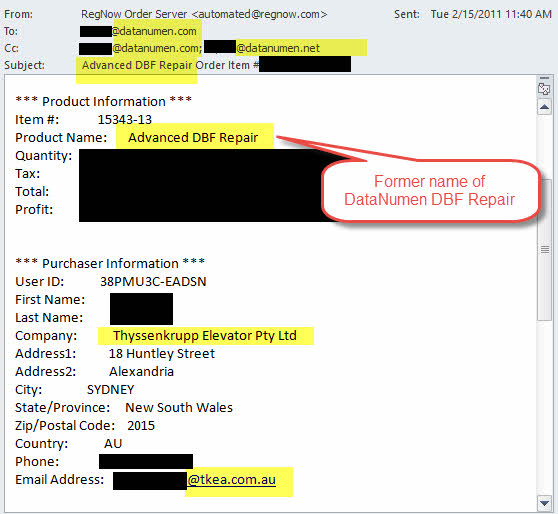1. Introduction
In the fast-paced world of elevator technology, where precision and timeliness are paramount, Thyssenkrupp Elevator, a subsidiary of the Fortune 500 company ThyssenKrupp, stands as a leader known for innovation and reliability. However, maintaining such a reputation requires unfaltering access to accurate data. An unexpected data corruption incident involving their DBF files threatened to disrupt operations. This case study explores how Thyssenkrupp Elevator, harnessing DataNumen DBF Repair, swiftly restored their vital databases, demonstrating foresight and strategic acumen to ensure business continuity.
2. Background
As a part of the Thyssenkrupp conglomerate, Thyssenkrupp Elevator operates globally, providing cutting-edge vertical transport solutions. From skyscraper elevators to residential lifts, their products are essential for daily activities across the globe. Central to these operations is the management of vast data repositories, from client profiles and transactional records to maintenance logs and manufacturing data. Any interruption or loss of this data can have ripple effects, influencing project delivery and customer satisfaction.
3. The Challenge
Unexpected challenges arose when a routine server update coincided with a sudden power failure, resulting in the corruption of several critical DBF files. These files were integral to their inventory management and scheduling systems. The corrupted files meant that engineers and technicians could not access the schedules needed for ongoing and upcoming projects, effectively stalling operations and creating bottlenecks in service delivery.
Efforts to restore these files using built-in database tools were unsuccessful, raising alarms at every tier of management and IT. The options were stark: manually re-enter data (a time-consuming and error-prone task) or find a specialized tool capable of recovering the plagued files with urgency and accuracy.
4. Why DataNumen DBF Repair?
In searching for a solution, Thyssenkrupp’s IT department evaluated several software options. DataNumen DBF Repair emerged as the most promising solution due to its distinguished features:
- High Recovery Rate: Known for its superior ability to recover corrupted DBF files compared to peers.
- Efficiency: Quick processing speeds meant minimal downtime, crucial for the company’s operational needs.
- Ease of Use: The user-friendly interface required minimal training for the IT staff, facilitating rapid adoption.
- Broad Compatibility: Supported all DBF file formats that Thyssenkrupp operated, thereby ensuring comprehensive recovery capabilities.
Below is the order(Advanced DBF Repair is the former name of DataNumen DBF Repair):
5. The Implementation Process
The deployment of DataNumen DBF Repair was meticulously planned and executed, comprising several key phases:
5.1 Installation and Setup
The installation phase was straightforward. Within minutes, the software was fully operational and ready for use. This rapid deployment was crucial given the urgency of the situation.
5.2 Detection and Assessment
The initial scan provided by DataNumen DBF Repair accurately assessed file corruption levels. The software quickly identified which files were salvageable and pinpointed damaged sectors, offering a clear map for restoration.
5.3 Database Recovery
With just a few clicks, the repair process began. Leveraging advanced algorithms, the tool reconstructed corrupted entries and restored them to their original states. The team could monitor progress in real-time, adding a layer of transparency to the recovery operation.
5.4 Verification and Testing
Post-recovery, it was imperative to verify data integrity. The team performed thorough checks to ensure the restored files were complete and functioned seamlessly within the existing systems. This included cross-referencing database logs and re-running reports to confirm accuracy.
6. Results and Benefits
The implementation of DataNumen DBF Repair yielded immediate and impactful results:
- Complete Data Restoration: Every affected DBF file was successfully recovered, with no data loss, preserving the richness and continuity of Thyssenkrupp’s databases.
- Operational Continuity: The quick recovery process allowed operations to resume without significant interruption, safeguarding project timelines and service delivery commitments.
- Cost Avoidance: While alternative solutions posed the risk of high costs associated with manual data recovery or system overhauls, DataNumen provided a cost-effective solution without compromising quality.
- Enhanced Preparedness: The successful operation bolstered Thyssenkrupp’s disaster recovery protocols, equipping the company with enhanced strategies for future contingencies.
7. Conclusion
The unexpected data corruption incident had the potential to cause significant disruptions at Thyssenkrupp Elevator. However, thanks to the strategic deployment of DataNumen DBF Repair, the company was able to overcome these challenges with agility and precision. This case study not only highlights the robustness of DataNumen’s solution but also underscores the importance of having reliable data recovery strategies in place.
In summary, Thyssenkrupp Elevator’s experience with DataNumen DBF Repair is a testament to the critical role that reliable, efficient, and comprehensive data recovery tools play in modern enterprises. With operations secure and data integrity restored, Thyssenkrupp continues to lead the way in providing uninterrupted, top-tier elevator solutions worldwide.

